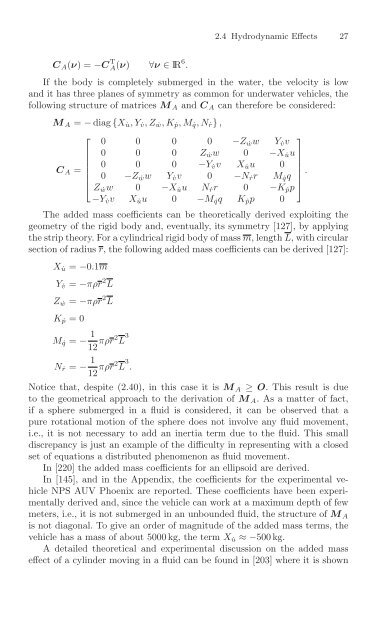Underwater Robots - Gianluca Antonelli.pdf
Underwater Robots - Gianluca Antonelli.pdf
Underwater Robots - Gianluca Antonelli.pdf
Create successful ePaper yourself
Turn your PDF publications into a flip-book with our unique Google optimized e-Paper software.
C A ( ν )=− C T A ( ν ) ∀ ν ∈ IR 6 .<br />
2.4 Hydrodynamic Effects 27<br />
If the body is completely submerged in the water, the velocity islow<br />
and ithas three planes of symmetry as common for underwater vehicles, the<br />
following structure ofmatrices M A and C A can therefore be considered:<br />
M A = − diag { X ˙u ,Y˙v ,Z˙w ,K˙p ,M˙q ,N˙r } ,<br />
⎡<br />
⎢<br />
C A = ⎢<br />
⎣<br />
0 0 0 0 − Z ˙w w Y˙vv 0 0 0 Z ˙w w 0 − X ˙u u<br />
0 0 0 − Y ˙v v X˙uu 0<br />
0 − Z ˙w w Y˙vv 0 − N ˙r r M˙qq Z ˙w w 0 − X ˙u u N˙rr 0 − K ˙p p<br />
− Y ˙v v X˙uu 0 − M ˙q q K˙pp 0<br />
The added mass coefficients can be theoretically derived exploiting the<br />
geometry of the rigid body and, eventually, its symmetry [127], by applying<br />
the strip theory. Foracylindrical rigid body of mass m ,length L ,with circular<br />
section of radius r ,the following added mass coefficients can be derived [127]:<br />
X ˙u = − 0 . 1 m<br />
Y ˙v = − πρr 2 L<br />
Z ˙w = − πρr 2 L<br />
K ˙p =0<br />
M ˙q = − 1<br />
12 πρr 2 L 3<br />
N ˙r = − 1<br />
12 πρr 2 L 3 .<br />
Notice that, despite (2.40), in this case it is M A ≥ O .This result is due<br />
to the geometrical approach tothe derivation of M A .Asamatter of fact,<br />
if asphere submerged in afluid is considered, it can beobserved that a<br />
pure rotational motion of the sphere does not involve any fluid movement,<br />
i.e., it is not necessary to add an inertia term due tothe fluid. This small<br />
discrepancy is just an example of the difficulty inrepresenting with aclosed<br />
set of equations adistributed phenomenon as fluid movement.<br />
In [220] the added mass coefficients for an ellipsoid are derived.<br />
In [145], and in the Appendix, the coefficients for the experimental vehicle<br />
NPS AUV Phoenix are reported. These coefficients have been experimentally<br />
derived and, since the vehicle can work atamaximum depth of few<br />
meters, i.e., it is not submerged in an unbounded fluid, the structure of M A<br />
is not diagonal. To give anorder of magnitude of the added mass terms, the<br />
vehicle has amass of about 5000 kg, the term X ˙u ≈−500 kg.<br />
Adetailed theoretical and experimental discussion on the added mass<br />
effect of acylinder moving in afluid can befound in [203] where itisshown<br />
⎤<br />
⎥ .<br />
⎥<br />
⎦






